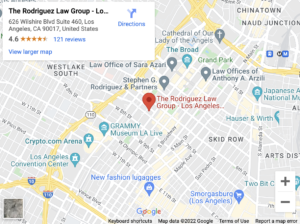What’s the Difference Between Theft, Robbery, and Burglary in California?

Being charged with the wrong offense can have life-changing consequences. For example, being accused of robbery instead of theft can mean facing years in prison rather than a lighter penalty.
These distinctions matter because each charge, theft, robbery, or burglary, carries different legal definitions and punishments under California law. Law enforcement or prosecutors may pursue the harshest possible charge, putting your future in balance.
Therefore, you should work with a legal professional during defense when the prosecution uses evidence that may blur the lines between these crimes.
A criminal defense lawyer can carefully examine the facts of your case, challenge the evidence, and argue for the correct and least severe charge. They understand California criminal law, allowing them to protect your rights, fight for reduced penalties, and work to prevent one mistake from defining your future.
Key Takeaway
- Theft, burglary, and robbery are distinct crimes in California with different elements and penalties. Theft involves taking property without force, burglary requires unlawful entry with intent, and robbery involves force or intimidation.
- Common defenses against these charges include lack of intent, mistaken identity, consent, insufficient evidence, self-defense, illegal search and seizure, and duress or coercion. A skilled lawyer tailors the strategy to your case.
- The cost of a criminal defense lawyer varies depending on the complexity of the case, the attorney’s experience, the location, and the fee structure.
- Call a criminal defense lawyer to minimize your consequences after a charge.
What’s the Difference Between Burglary, Robbery, and Theft
There are distinctions between burglary, robbery, and theft in California because each carries different legal elements and penalties. These crimes are often confused, but they involve distinct circumstances and consequences.
Theft in California
Theft occurs when someone unlawfully takes another person’s property to permanently deprive the owner of that property. It is the broadest category and includes shoplifting, pickpocketing, and stealing unattended items.
Here are the key elements of theft:
- Taking someone else’s property
- Without permission
- With the intent to permanently deprive the owner

Types of Theft
- Petty theft: Petty theft in California involves stealing property valued at $950 or less, as defined by Penal Code Section 484(a). It’s a misdemeanor, punishable by up to 6 months in jail, a $1,000 fine, or both. Common examples include shoplifting or taking small items without consent.
- Grand theft: Grand theft in California, under Penal Code Section 487, involves stealing property valued over $950, specific items like firearms or vehicles, or property directly from a person. It’s a wobbler, chargeable as a misdemeanor or felony, with penalties up to 7 years in prison or a $7,000 fine.
Robbery in California
Robbery involves taking property from another person through force or fear, directly from their person or immediate presence. Robbery is considered a violent crime because it involves confrontation with the victim.
Here are the key elements of robbery:
- Taking property from a person or their immediate presence
- Using force, violence, or intimidation
- The intent to permanently deprive the owner
Examples: Armed robbery, muggings, carjackings, or threatening someone to hand over their wallet.
Consequences of Robbery
- First-degree robbery: First-degree robbery is a felony punishable by 3 to 9 years in state prison. Examples include using a weapon to demand money from someone inside a bank or threatening a driver with a knife to take their vehicle.
- Second-degree robbery: Felony punishable by 2 to 5 years in state prison. Examples of second-degree robbery include street mugging or store robbery.
- Additional enhancements for weapon use can add years to sentences.
Burglary in California
Burglary occurs when someone unlawfully enters any structure intending to commit theft or a felony. The crime is complete upon entry with criminal intent, regardless of whether they stole anything.
Here are the key elements of burglary:
- Unlawful entry into a structure
- Intent to commit theft or a felony inside
- Entry can be minimal
Types of Burglary
- First-Degree Burglary: First-degree burglary in California, under Penal Code Section 459, involves unlawfully entering an inhabited dwelling, like a home or apartment, with the intent to commit theft or a felony. It’s a felony, punishable by up to 7 years in prison. The structure must be occupied, even if residents are temporarily absent.
- Second-Degree Burglary: Second-degree burglary in California involves unlawfully entering a non-inhabited structure, such as a store, warehouse, or commercial building, with the intent to commit theft or a felony. It’s a wobbler, chargeable as a misdemeanor or felony, with penalties up to 3 years in prison or a $7,000 fine. Prior convictions may increase penalties.
A criminal defense attorney can potentially argue for reduced charges when the evidence doesn’t support the more serious offense. For example, if prosecutors charge burglary but can’t prove unlawful entry or criminal intent, they can argue for reducing the charge to theft.
What Common Defenses Exist Against Robbery, Burglary, or Theft Charges?
A criminal defense attorney can employ various strategic defenses when fighting robbery, burglary, and theft charges. Each defense requires careful legal analysis and evidence presentation to challenge the prosecution’s case.
Here are some of the possible defense strategies:

Lack of Intent
Lack of intent is a defense strategy for theft, burglary, or robbery charges. For example, in burglary, proving no intent to commit theft or a felony upon entry can negate the charge, potentially leading to acquittal or reduced charges.
A criminal defense attorney can gather evidence showing the defendant’s true intentions, such as witness testimony about the defendant’s state of mind. They can also rely on documentation to prove legitimate reasons for being present.
They may also present expert testimony regarding mental health conditions or substance abuse issues that impacted the defendant’s ability to form criminal intent.
Mistaken Identity
You can use mistaken identity as a defense strategy for robbery, burglary, or theft charges. It asserts the defendant was wrongly identified as the perpetrator, using evidence like alibis or witness errors to challenge the prosecution’s case for acquittal.
A criminal defense attorney can investigate alibi evidence, review surveillance footage, examine witness reliability, and challenge identification procedures.
They may also hire expert witnesses to testify about the unreliability of eyewitness identification, particularly in high-stress situations. A criminal defense lawyer can also scrutinize police lineup procedures for constitutional violations that can taint identification evidence.
Consent or Permission
Consent or permission is an alternative defense strategy for robbery, burglary, or theft charges. It asserts the defendant had the owner’s permission to take or enter the property. The strategy can negate unlawful intent, potentially leading to an acquittal.
A criminal defense attorney can gather documentation, witness testimony, or communication records showing permission was granted. They may present evidence of relationships between the defendant and the alleged victim that would reasonably suggest consent.
For burglary cases, a criminal defense lawyer can investigate lease agreements, employment records, or family relationships that can establish lawful entry rights.
Insufficient Evidence
It is a strategy that involves challenging whether the prosecution can prove all elements of the crime beyond a reasonable doubt.
A criminal defense attorney can scrutinize every piece of evidence, identify gaps in the prosecution’s case, and file motions to suppress illegally obtained evidence. They may also cross-examine witnesses to reveal inconsistencies, challenge forensic evidence, and highlight reasonable doubt.
A criminal defense attorney may hire private investigators to uncover exonerating evidence or alternative theories of the crime.
Self-Defense
Self-defense claims the defendant’s actions were necessary to protect themselves from immediate harm. For example, if someone threatens you with a weapon and you take their property while defending yourself, this can justify actions that might otherwise constitute robbery.
A criminal defense lawyer can investigate the alleged victim’s history of violence. They can also gather evidence against the defendant and present witness testimony supporting the self-defense claim.
They analyze medical records, police reports, and physical evidence to build a compelling argument showing the defendant reasonably feared for their safety.
Illegal Search and Seizure
Illegal search and seizure challenges evidence obtained without proper warrants, probable cause, or consent, violating Fourth Amendment rights.
For example, if police searched your car without permission during a traffic stop and found stolen goods. A criminal defense lawyer can suppress that evidence, weakening the prosecution’s theft case.
A criminal defense attorney can file a motion to suppress evidence obtained through illegal searches. They can challenge whether the police had proper warrants, probable cause, or consent.
They may also scrutinize police procedures, interview officers about their actions, and argue constitutional violations before judges.
Duress or Coercion
Duress or coercion claims the defendant was forced to commit the crime under threat of immediate harm to themselves or loved ones.
For example, if someone threatens to hurt your family unless you rob a store. The external pressure can serve as a defense, showing that you acted out of fear rather than criminal intent.
A criminal defense lawyer can investigate the defendant’s circumstances leading to the alleged crime. They can gather evidence of threats or coercion and present expert testimony about duress situations.
They may also examine patterns of abuse or control that influenced the defendant’s actions.
How Much Does a Criminal Defense Lawyer Cost
There is no average charge for a criminal defense attorney. The cost varies based on the following factors:
- Case Complexity: A criminal defense lawyer charges less for simple misdemeanor cases than for complex felony charges requiring extensive investigation, expert witnesses, or lengthy trials. They may charge higher for multiple charges or cases involving technical evidence.
- Attorney Experience: A highly experienced criminal defense attorney with a proven track record generally charges higher rates than newer practitioners.
- Geographic Location: Criminal defense lawyers apply varying fees by region. A criminal defense lawyer in an urban area may charge a higher rate than those in rural locations due to the cost of living and market demand.
- Fee Structure: A criminal defense attorney may charge flat fees for straightforward cases, hourly rates for complex matters, or retainer agreements.
- Case Duration: A criminal defense lawyer may charge higher for cases requiring multiple court appearances, lengthy negotiations, or trials extending over months.
A Criminal Defense Attorney Can Reduce the Severity of Your Case
A district attorney can accuse you of burglary instead of theft. While theft might carry fines, probation, or a short jail term, burglary is considered a more serious felony, leading to years in prison and a permanent felony record.
The difference in charges can affect your career, housing opportunities, and reputation for the rest of your life. Building a strong legal defense is challenging, especially when evidence, witness statements, or intent are unclear.
A criminal defense attorney can challenge weak evidence, negotiate with prosecutors, and work to reduce your charge to a less severe offense. They can push to minimize penalties or even secure alternative sentencing.
Contact a criminal defense lawyer to fight for a less severe charge.

Frequently Asked Questions
How Can a Criminal Defense Lawyer Help Fight or Reduce My Charges?
A criminal defense lawyer can challenge evidence, negotiate with prosecutors for reduced charges, and identify weaknesses in the prosecution’s case. They understand the distinct legal elements of theft, robbery, and burglary.
They can argue for lesser charges when the evidence doesn’t support more serious allegations. A criminal defense attorney can secure plea bargains, dismissals, or alternative sentencing options while protecting your constitutional rights throughout proceedings.
Can I Argue There Wasn’t the Intent to Commit Theft or Entry Into a Building?
Yes, intent is a foundation element in theft and burglary charges. A criminal defense lawyer can argue lack of intent by presenting evidence that you didn’t intend to steal or unlawfully enter.
They can demonstrate that you had permission, mistaken ownership, or no criminal purpose. Challenging intent can result in reduced charges or case dismissal.
Can I Face Burglary Charges Even if Nothing Was Stolen?
Yes, you can face burglary charges even if nothing was stolen. Burglary requires only unlawful entry into a structure, with the intent to commit theft or another felony inside.
The crime is complete upon entry with criminal intent, regardless of whether anything was taken. A criminal defense attorney can challenge the prosecution’s evidence regarding unlawful entry and criminal intent.


